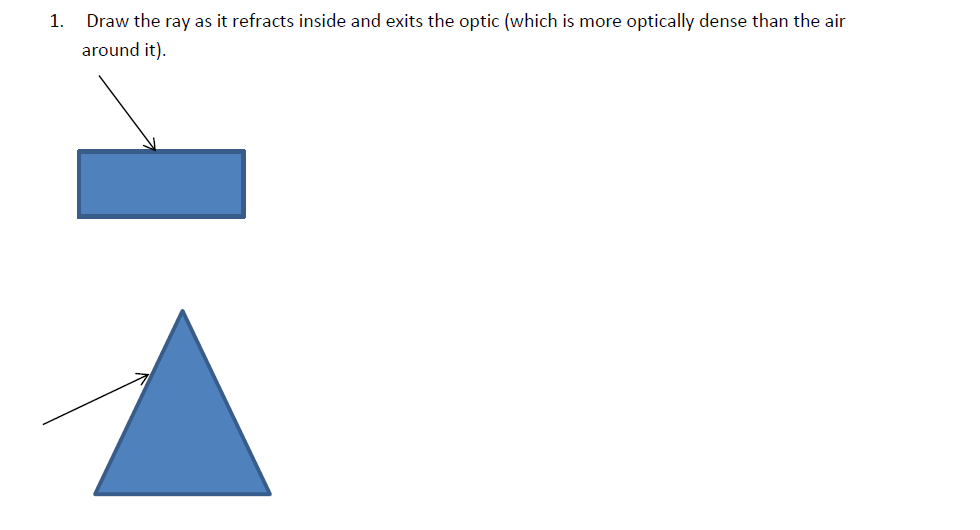
As shown and discussed in class, light refracts TOWARD a normal line (dotted line on the left image, perpendicular to surface of lens) when entering a more dense medium.
Note in this
convex lens that this direction of bend changes from down (with the top ray) to up with the bottom ray. This is due to the geometry of the lens. Look at the picture to make sure that this makes sense. As a result, the rays will intersect after leaving the lens. An image can form!
The FOCAL LENGTH (f) of a lens (or curved mirror) where the light rays would intersect, but ONLY IF THEY WERE INITIALLY PARALLEL to each other. Otherwise, they intersect at some other point, or maybe not at all (if the object is too close to be focused on)!
Note that your (human) eye lenses are convex - slightly thicker in the middle. Thus, your eyes form "real" images on the retina - upside-down! Unless, of course, the object is too close.
If an image is projected onto a screen, the image is REAL. Convex lenses (fatter in the middle) CAN create real images - the only cases where there are no images for convex lenses are when the object distance (between object and lens) is equal to the f, or when do < f. In the first case, there is NO image at all. In the second case, there is a magnified upright virtual image "inside" the lens.
Concave lenses (thinner in the middle) NEVER create real images and ONLY/ALWAYS create virtual images.
Top image depicts parallel light rays hitting a convex lens and meeting at the "focal point."
A real image forms at the focal length of a convex lens, WHEN THE RAYS ARE INITIALLY PARALLEL. People who are farsighted wear convex lenses.
The bottom image depicts parallel light rays hitting a concave lens and diverging. In this case, under all circumstances (regardless of where the object is), only virtual images are formed. These can not be projected onto a screen - rather, they appear to reside "inside" the lens. People who are nearsighted wear concave lenses.

However, unless the light rays are exactly parallel (or the object is so far away, like the Sun, so that they are approximately parallel), the light rays do not behave exactly like this. Rather, they form at a different location.
Extension to curved mirrors:
Convex lenses (which are defined to have a positive focal length) are similar to concave mirrors.
Concave lenses (which are defined to have a negative focal length) are similar to convex mirrors.
Summary
The key thing to note is that whether or not an image forms, and what characteristics that image has, depends on:
- type of lens or mirror
- how far from the lens or mirror the object is
In general, convex lenses (and concave mirrors) CAN form "real" images. In fact, they always form real images (images that can be projected onto screens) if the object is further away from the lens/mirror than the focal length. Think of using a magnifying glass to burn leaves - a real image of the Sun is forming on the leaves.
If the object is AT the focal point, NO image will form.
If the object is WITHIN the focal point (less than the focal point), only virtual images (larger ones) will form "inside" the mirror or lens.
Concave lenses and convex mirrors ONLY form virtual images; they NEVER form real images. Think of convenience store mirrors and glasses for people who are nearsighted.
Extra info, FYI:
The location of images can be predicted by a powerful equation:
1/f = 1/di + 1/do
In this equation, f is the theoretical focal length (determined by the geometry of the lens or mirror), do is the distance between the object and lens (or mirror) and di is the distance from lens (or mirror) to the formed image.
We find several things to be true when experimenting with lenses. If the object distance (do) is:
greater than 2f -- the image is smaller
equal to 2f -- the image is the same size as the object (and is located at a di equal to 2f)
between f and 2f -- the images is larger
at f -- there is NO image
within f -- the image is VIRTUAL (meaning that it can not be projected onto a screen) and it appears to be within the lens (or mirror) itself

























